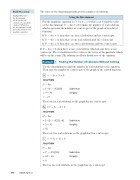Page 785 - Algebra 1
P. 785
Math Reasoning
Analyze What does
the discriminant
tell about the real solutions of a quadratic equation? What does the discriminant not tell about the solutions of a quadratic equation?
The value of the discriminant indicates the number of solutions.
Using the Discriminant
For the quadratic equation ax2 + bx + c = 0 where a ≠ 0, find the value of the discriminant, b2 - 4ac, to determine the number of real solutions, which represents the number of x-intercepts of the graph of its related function.
If b2 - 4ac < 0, then there are no real solutions and no x-intercepts. If b2 - 4ac = 0, then there is one real solution and one x-intercept.
If b2 - 4ac > 0, then there are two real solutions and two x-intercepts.
If b2 - 4ac = 0, then there is one real solution, which means there is one x-intercept. The real solution is the x value at the vertex of the parabola, which will be on the x-axis. The solution is called a double root of the equation.
Finding the Number of Solutions Without Solving
Use the discriminant to find the number of real solutions to the equation. Then state the number of x-intercepts of the graph of the related function.
a. x2-3x+9=0 SOLUTION
b2 - 4ac
= (-3)2 - 4(1)(9)
= 9 - 36
= -27
There are no real solutions, so the graph has no x-intercepts.
b. 2x2 -3x-4=0 SOLUTION
b2 - 4ac
= (-3)2 - 4(2)(-4)
= 9 + 32
= 41
There are two real solutions, so the graph has two x-intercepts.
c. x2 +8x+16=0 SOLUTION
b2 - 4ac
= 82 - 4(1)(16)
= 64 - 64
=0
There is one real solution, so the graph has one x-intercept.
Example
1
Substitute. Simplify.
Substitute. Simplify.
Substitute. Simplify.
770 Saxon Algebra 1


